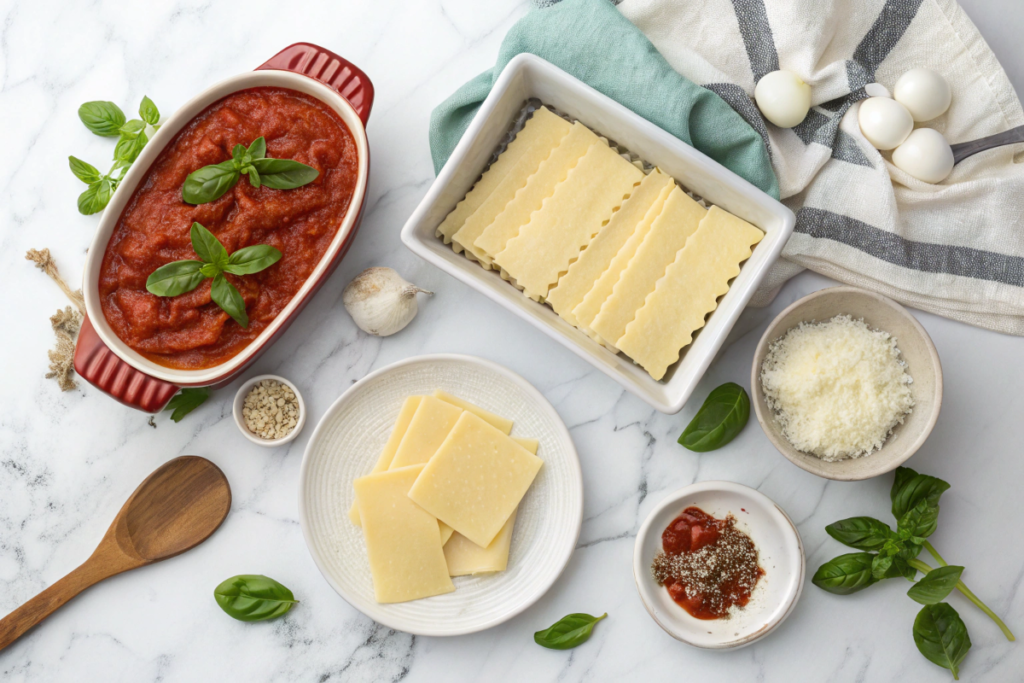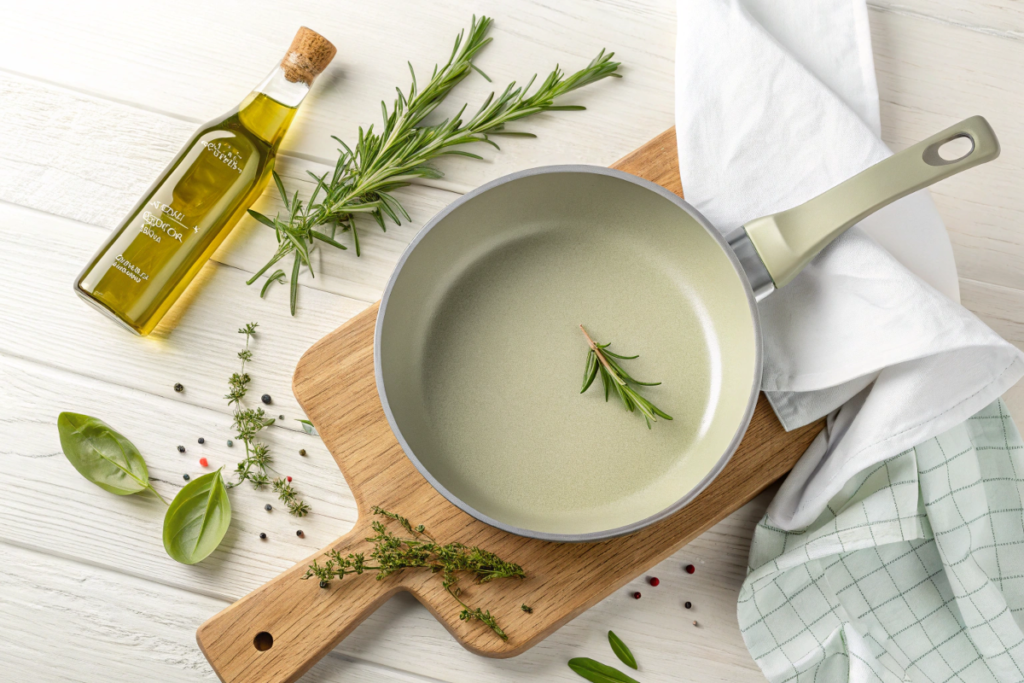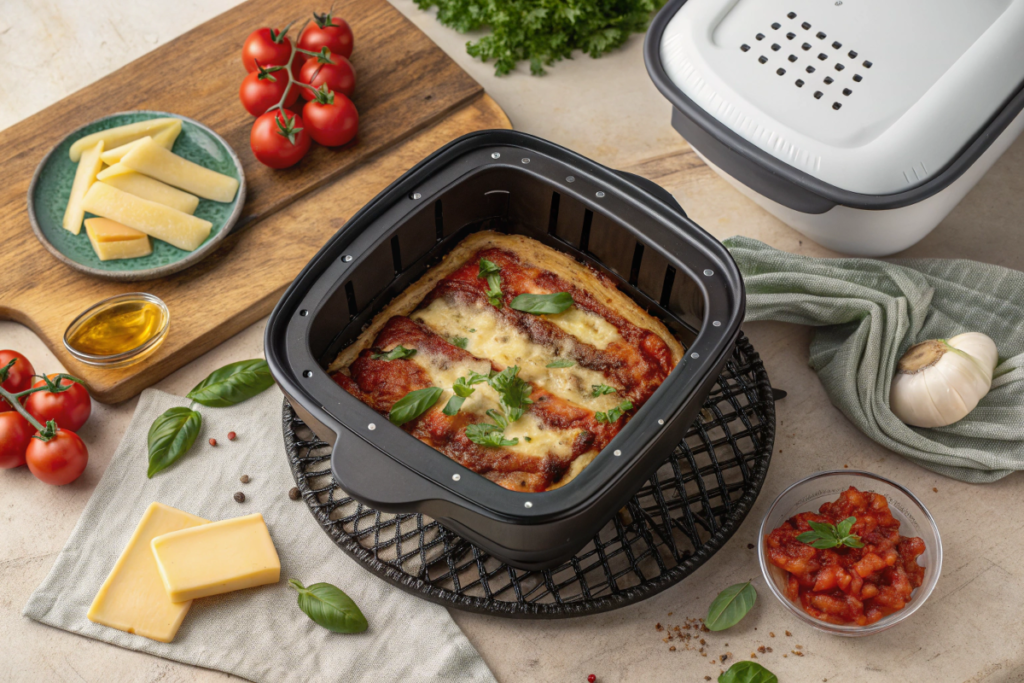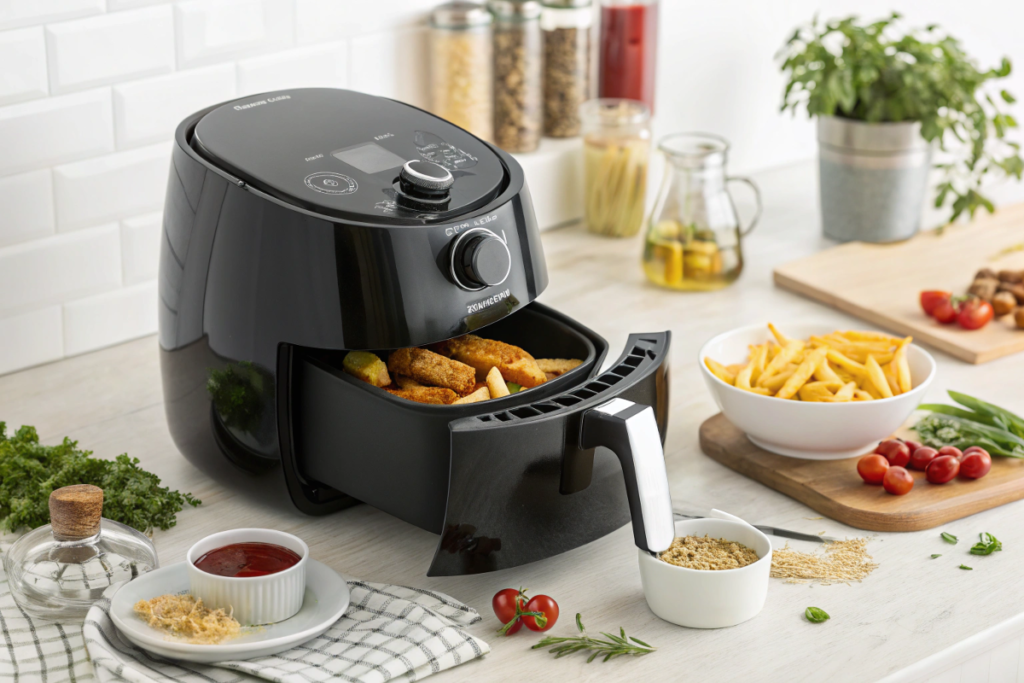Air fryers have transformed the way we cook, offering a healthier and more convenient alternative to traditional frying methods. As versatile as they are, many users wonder about the types of cookware that are safe to use inside an air fryer. One common question is: Can you put a ceramic dish in an air fryer?
This guide explores the use of ceramic cookware in air fryers, highlighting safety tips, benefits, potential risks, and practical advice to help you make informed decisions in your kitchen. If you’re wondering about using glass in an air fryer, check out this guide.
What Is an Air Fryer and How Does It Work?
Understanding the Heating and Airflow Mechanisms
An air fryer is a countertop appliance designed to cook food by circulating hot air around it. This process, known as convection cooking, mimics the results of deep frying but uses significantly less oil. The air fryer consists of a heating element and a powerful fan that work together to produce rapid air circulation.
This mechanism ensures that food cooks evenly and develops a crispy exterior while maintaining a tender interior. Understanding how an air fryer operates is crucial when selecting appropriate cookware, such as ceramic dishes, to ensure safe and effective cooking.
Types of Cookware Suitable for Air Fryers
Overview of Materials Like Ceramic, Glass, and Metal
Choosing the right cookware is essential for optimizing your air frying experience. Common materials suitable for air fryers include:
- Ceramic: Known for its non-stick properties and even heat distribution.
- Glass: Provides transparency to monitor cooking progress but can be fragile.
- Metal: Durable and excellent for high-temperature cooking, often preferred for its reliability.
- Silicone: Flexible and non-stick, ideal for certain baking applications.
Each material has its advantages and limitations, making it important to understand their compatibility with air fryer settings. Ceramic cookware, in particular, has gained popularity due to its aesthetic appeal and cooking benefits. However, not all ceramic dishes are created equal, and knowing which ones are safe for air fryers is essential.
Can You Put a Ceramic Dish in an Air Fryer?
A Detailed Answer with Pros and Cons
Can you put a ceramic dish in an air fryer? Yes, you can, but with certain precautions. Ceramic dishes can be a great addition to your air fryer arsenal due to their non-reactive surfaces and ability to distribute heat evenly. However, there are both benefits and drawbacks to consider:
Pros:
- Non-Stick Surface: Facilitates easy food release and cleaning.
- Even Heating: Ensures consistent cooking without hotspots.
- Aesthetic Appeal: Adds a stylish touch to your cooking process.
Cons:
- Fragility: Ceramic can crack or shatter if subjected to sudden temperature changes.
- Weight: Some ceramic dishes may be too heavy for certain air fryer baskets.
- Size Limitations: Ensuring the dish fits comfortably without blocking airflow is crucial.
By weighing these pros and cons, you can determine whether ceramic cookware suits your air frying needs.
Benefits of Using Ceramic Dishes in an Air Fryer
Heat Retention, Non-Reactive Surfaces, and Ease of Cleaning
Using ceramic dishes in your air fryer offers several advantages:
- Heat Retention: Ceramic maintains consistent temperatures, which is ideal for dishes that require even cooking.
- Non-Reactive Surfaces: Ceramic does not react with acidic or alkaline foods, preserving the taste and integrity of your meals.
- Ease of Cleaning: Most ceramic cookware is dishwasher safe and resists stains and odors, making cleanup a breeze.
These benefits make ceramic dishes a popular choice for air frying, especially for recipes that benefit from gentle and even heat distribution.
Risks of Using Ceramic Dishes in an Air Fryer
Potential for Cracking, Weight Issues, and Compatibility Concerns
While ceramic cookware has its perks, there are inherent risks associated with its use in air fryers:
- Cracking: Sudden temperature changes, known as thermal shock, can cause ceramic dishes to crack or shatter.
- Weight Issues: Heavier ceramic dishes may strain the air fryer’s motor or interfere with the basket’s movement.
- Compatibility Concerns: Not all ceramic dishes fit well in air fryers. Oversized or irregularly shaped dishes can block airflow, leading to uneven cooking.
Being aware of these risks allows you to take preventive measures, ensuring your ceramic dishes remain safe and effective when used in an air fryer.
Factors to Consider Before Using Ceramic in an Air Fryer
Heat Resistance, Size, and Weight Considerations
Before incorporating ceramic dishes into your air frying routine, evaluate the following factors:
- Heat Resistance: Ensure the ceramic dish is labeled as oven-safe or heat-resistant to withstand the high temperatures of air frying.
- Size: Choose a ceramic dish that fits comfortably within your air fryer’s basket without obstructing the airflow.
- Weight: Opt for lightweight ceramic cookware to prevent undue stress on the air fryer’s components.
- Lid Compatibility: If your ceramic dish has a lid, verify that it can withstand the air fryer’s heat and does not trap moisture excessively.
Considering these factors helps in selecting the right ceramic dish, promoting safe and efficient air frying.
How to Test if a Ceramic Dish Is Air Fryer Safe
Simple Methods to Check Heat Tolerance and Fit
To determine whether your ceramic dish is suitable for air frying, follow these simple tests:
- Heat Resistance Check:
- Review Manufacturer’s Instructions: Look for labels indicating oven-safe or specific temperature ratings.
- Conduct a Heat Test: Place the ceramic dish in a preheated oven at a moderate temperature for a few minutes to observe any signs of cracking or damage.
- Fit and Size Evaluation:
- Measure Air Fryer Basket: Compare the dish’s dimensions with your air fryer’s basket to ensure a proper fit.
- Check Airflow Clearance: Ensure there is sufficient space around the dish for air to circulate freely.
- Weight Assessment:
- Lift Test: Ensure the ceramic dish is not excessively heavy, which could strain the air fryer’s motor.
Performing these tests helps confirm the safety and suitability of your ceramic cookware for air frying.
Common Mistakes When Using Ceramic in an Air Fryer
Overcrowding, Uneven Heating, or Using the Wrong Temperature
Avoiding common errors can enhance your air frying experience with ceramic dishes:
- Overcrowding the Basket: Placing too much food or using oversized dishes can block air circulation, resulting in uneven cooking.
- Using Incorrect Temperatures: Exceeding the ceramic dish’s heat tolerance can cause cracking or shattering. Always adhere to recommended temperature settings.
- Neglecting Preheating: Skipping the preheating step may lead to longer cooking times and less crispy results.
- Using Cold Dishes: Introducing cold ceramic dishes into a hot air fryer can cause thermal shock. Allow dishes to reach room temperature before air frying.
By steering clear of these mistakes, you ensure a smoother and more effective air frying process with your ceramic cookware.
Recipes Perfect for Ceramic Dishes in an Air Fryer
Examples Like Casseroles, Baked Goods, and Reheated Leftovers
Ceramic dishes are ideal for a variety of air fryer recipes. Here are some delicious options:
- Air Fryer Lasagna:
- Ingredients:
- 6 lasagna noodles, cooked
- 1 cup marinara sauce
- 1 cup ricotta cheese (use vegan alternatives if desired)
- 1 cup shredded mozzarella
- 1/2 cup grated Parmesan
- Fresh basil for garnish
- Directions:
- Layer lasagna noodles, marinara sauce, ricotta cheese, and mozzarella in a ceramic dish.
- Repeat layers and top with Parmesan cheese.
- Place the dish in the air fryer and cook at 350°F (175°C) for 15-20 minutes until bubbly and golden.
- Garnish with fresh basil before serving.
- Ingredients:
- Air Fryer Frittata:
- Ingredients:
- 6 eggs (use egg substitute for vegan version)
- 1/2 cup diced vegetables (bell peppers, onions, spinach)
- 1/4 cup shredded cheese (use vegan cheese if preferred)
- Salt and pepper to taste
- Directions:
- Whisk eggs with salt and pepper in a ceramic bowl.
- Stir in diced vegetables and cheese.
- Pour the mixture into the ceramic dish and place in the air fryer.
- Cook at 320°F (160°C) for 12-15 minutes until set.
- Let cool slightly before slicing and serving.
- Ingredients:
- Air Fryer Apple Crisp:
- Ingredients:
- 4 apples, peeled and sliced
- 1/4 cup brown sugar
- 1 teaspoon cinnamon
- 1/2 cup rolled oats
- 1/4 cup flour
- 1/4 cup coconut oil, melted
- Directions:
- Toss apple slices with brown sugar and cinnamon in a ceramic dish.
- In a separate bowl, mix oats, flour, and melted coconut oil until crumbly.
- Sprinkle the oat mixture over the apples.
- Air fry at 350°F (175°C) for 15 minutes until the topping is golden brown.
- Serve warm with vegan ice cream if desired.
- Ingredients:
These recipes showcase the versatility of ceramic dishes in an air fryer, allowing you to create hearty meals, delightful desserts, and everything in between with ease.

Cleaning and Maintenance Tips for Ceramic Cookware
Proper Care to Extend the Life of Your Ceramic Dishes
Maintaining your ceramic cookware ensures longevity and optimal performance:
- Immediate Cleaning: Clean the ceramic dish soon after use to prevent food residue from hardening.
- Avoid Abrasive Cleaners: Use soft sponges and mild detergents to prevent scratching the ceramic surface.
- Hand Wash Preferred: While some ceramic dishes are dishwasher safe, hand washing prolongs their lifespan.
- Dry Thoroughly: Ensure the dish is completely dry before storing to prevent moisture buildup and potential mold.
- Check for Damage: Regularly inspect the ceramic for cracks or chips and discontinue use if damaged to avoid accidents.
Following these maintenance tips keeps your ceramic dishes in excellent condition, ready for your next air frying adventure.
FAQs About Ceramic Dishes and Air Fryers
Can ceramic cookware withstand high temperatures in an air fryer?
Most ceramic dishes are heat-resistant and can handle the temperatures used in air frying. However, always check the manufacturer’s guidelines to ensure compatibility.
Are all ceramic dishes suitable for air fryers?
No, not all ceramic dishes are designed for air fryers. Look for dishes labeled as oven-safe or suitable for high-heat cooking.
Will ceramic dishes block airflow in the air fryer?
If the ceramic dish is too large or placed incorrectly, it can obstruct airflow, leading to uneven cooking. Ensure proper sizing and placement to maintain optimal air circulation.
Can I use ceramic ramekins in my air fryer?
Yes, ceramic ramekins can be used for individual servings, such as mini casseroles or desserts. Just ensure they fit comfortably within the air fryer basket.
Ceramic vs. Other Cookware for Air Fryers
Comparison with Glass, Metal, and Silicone
When selecting cookware for your air fryer, consider how ceramic compares to other materials:
- Glass: Transparent but can be fragile. Offers similar heat distribution to ceramic but may crack under thermal shock.
- Metal: Highly durable and excellent for high-temperature cooking. However, metal can react with acidic foods and may scratch non-stick surfaces.
- Silicone: Flexible and non-stick, ideal for certain baking tasks. Not suitable for all recipes as it can retain flavors.
- Ceramic: Non-reactive, offers even heating, and is aesthetically pleasing. Requires careful handling to prevent cracking.
Choosing between these materials depends on your cooking needs, the type of recipes you prepare, and your preference for durability versus aesthetics.
Benefits of Using Ceramic Cookware Beyond Air Fryers
Versatility in the Kitchen and Health Benefits
Ceramic cookware extends its benefits beyond air frying:
- Versatile Cooking: Suitable for baking, roasting, and stovetop cooking, making it a multipurpose kitchen tool.
- Health Benefits: Ceramic is free from harmful chemicals like PFOA and PTFE found in some non-stick coatings, ensuring healthier cooking.
- Aesthetic Appeal: Adds a stylish touch to your kitchen and dining presentation.
- Easy Maintenance: Non-stick properties make cleaning effortless, promoting a hygienic cooking environment.
These advantages make ceramic cookware a valuable addition to any kitchen, enhancing both functionality and health.
Safety Precautions for Using Ceramic Dishes
Avoiding Thermal Shock and Ensuring Proper Placement
To safely use ceramic dishes in your air fryer, follow these precautions:
- Avoid Thermal Shock: Do not place cold ceramic dishes directly into a hot air fryer. Allow them to reach room temperature before cooking.
- Proper Placement: Position the ceramic dish in a way that does not obstruct the air fryer’s airflow. Ensure there is ample space around the dish for hot air to circulate.
- Use Heat-Resistant Handles: Ensure that any handles or lids on the ceramic dish are also heat-resistant to prevent melting or deformation.
- Monitor Cooking: Keep an eye on the cooking process to quickly address any issues like cracking or splattering.
- Store Carefully: Handle ceramic dishes with care to prevent drops or impacts that could cause cracks or chips.
Adhering to these safety measures ensures a safe and efficient air frying experience with your ceramic cookware.

Conclusion
Can you put a ceramic dish in an air fryer? Absolutely, but with the right precautions. Ceramic dishes offer numerous benefits, including even heat distribution, non-reactive surfaces, and ease of cleaning, making them a great choice for air frying. However, it’s essential to select the appropriate ceramic cookware, understand the potential risks, and follow safety guidelines to ensure successful and safe cooking.
By choosing heat-resistant, appropriately sized ceramic dishes and avoiding common mistakes like overcrowding and improper temperature settings, you can enjoy a wide range of delicious air-fried meals and desserts. Whether you’re preparing casseroles, baked goods, or reheated leftovers, ceramic cookware can enhance your air frying experience, providing both functionality and aesthetic appeal.
Embrace the versatility of ceramic dishes in your air fryer and explore the endless culinary possibilities they offer. With careful selection and proper use, ceramic cookware can become a staple in your air frying routine, delivering tasty and perfectly cooked results every time.
Happy cooking!










